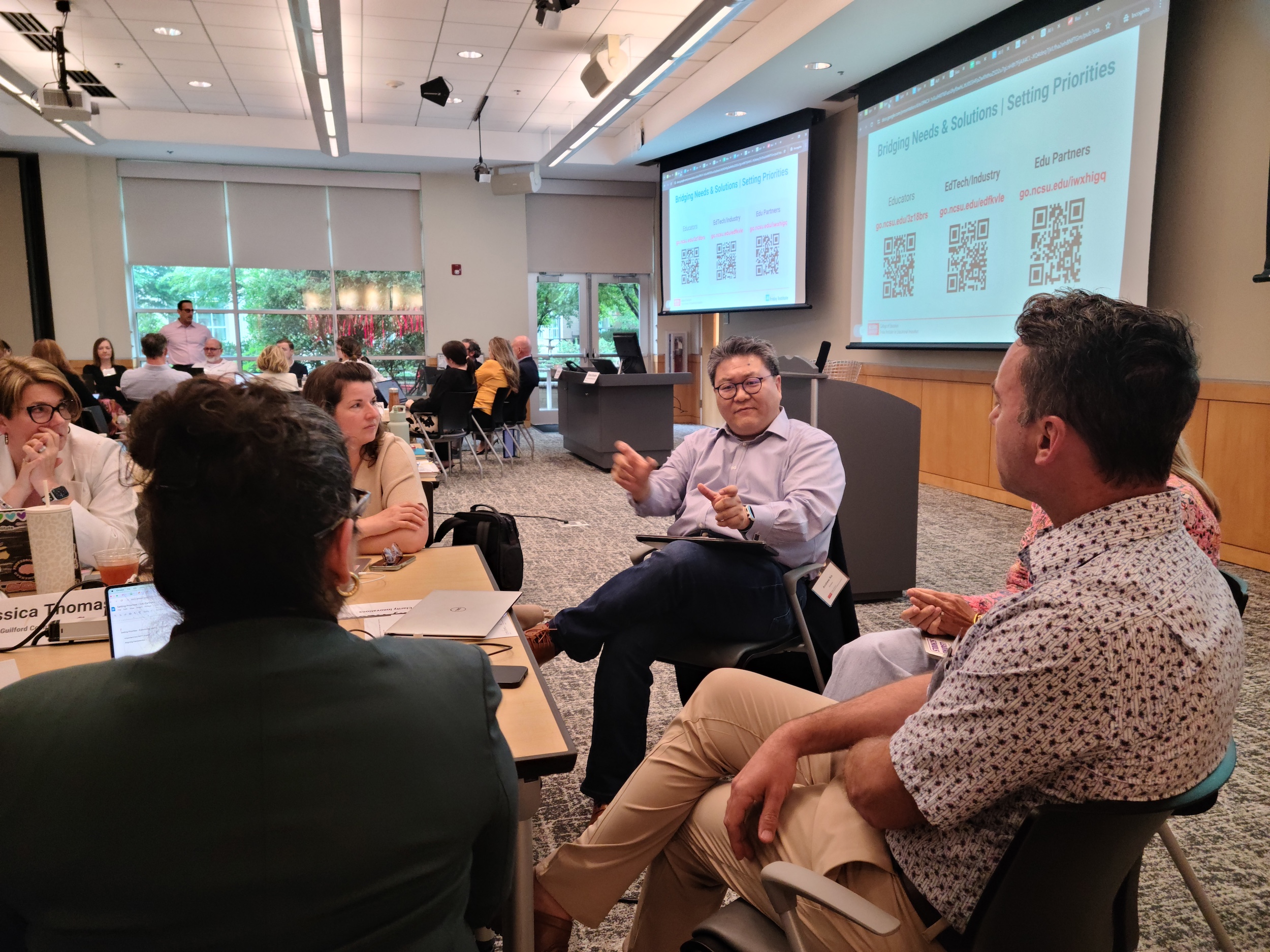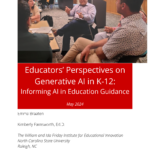Educators’ Perspectives on Generative AI in K-12: Informing AI in Education Guidance

Overview
The rapid development of generative AI is transforming the educational landscape. Educators from the classroom to the district office are confronted with new challenges and uncertainties regarding safe, equitable and effective implementation. This study explored education leaders’ perceptions and experiences with AI integration in K-12 education through interview and focus group data collection during the Friday Institute’s AI in K-12 Education Convening. At the culmination of the 2023-24 school year, the study’s findings are compared against guidance for AI in K-12 education published by 12 state education agencies.
Background
As educators navigate a constantly evolving and often confusing landscape regarding the impact of generative AI on K-12 education, limited studies on educators’ perceptions of generative AI reveal concerns about equity, impact on curricula, teacher workloads, student privacy and funding. Kaplan-Rakowski et al. (2023) found that educators generally view AI positively for its potential to reduce workloads, deepen student learning and foster meaningful human connection in the classroom. However, education leaders face challenges in effectively leading and ensuring ethical and meaningful integration of AI into K-12 classrooms.
In Fall 2023, the William and Ida Friday Institute for Educational Innovation, a part of the College of Education at North Carolina State University, hosted an event tailored for district and state leaders in partnership with SparkNC, the EngageAI Institute, and the Consortium for School Networking (COSN). During the event, participants discussed the landscape of AI in K-12 education, integrating AI in schools and classrooms, and further recommendations for safe and responsible AI in K-12 learning environments. Activities and interviews were developed to explore the research questions identified in this research study.
Research Questions
The following research questions guided the study:
- What perceptions do education leaders hold about how AI impacts teachers and classroom instruction?
- What perceptions do education leaders hold about how AI impacts students and learning?
- Where do education leaders identify AI as potentially integrating within existing systems of practice?
- What do education leaders identify as potential needs for new systems of practice leading to AI integration?
- What systems have education leaders implemented to evaluate the impact of AI on K-12 instruction and learning?
Methods
The study used qualitative data collection and analysis methods, including deductive content analysis. Education leaders’ perceptions and expectations of AI in K-12 education surfaced through the data analysis process. A convenient sample of participants consisted of approximately 40 education leaders (from state and district levels) and education researchers (from higher education and national non-profits) who participated in semi-structured interviews and focus groups during an AI in K-12 Education Convening. This event was held at the Friday Institute for Educational Innovation at North Carolina State University in Raleigh, NC. Participants were invited to attend; however, only those who consented to participate in this study were included in data collection. The interview and focus group data were transcribed and coded using an a priori coding scheme, with additional codes emerging during the content analysis process.
Study Findings
Deductive content analysis using the a priori coding scheme mentioned revealed five themes related to education leaders’ perceptions of AI integration into K-12 environments.
⇒ AI has the potential to transform teacher work
Participants were optimistic about the potential positive impact of generative AI for teachers. Education leaders shared that AI could help lighten teacher loads by helping them save time. For example, they shared that generative AI tools could be used as a resource in preparing lesson plans or other materials, allowing teachers to focus on connecting with students and supporting them in the process of learning. One education leader shared:
There are very few things that I’ve come across in my career that actually give time back to teachers and staff, and this is one of those things. This can cut out those mundane, repetitive tasks and allow teachers the ability to really sit with students one-on-one to really invest in the human relationships that can never be replaced with technology. (Director of Digital Learning)
⇒ AI has the potential to transform learning
Education leaders were similarly optimistic about the potential for AI to transform learning, allowing students and teachers to focus more on the learning process as opposed to the product. Participants felt that generative AI integration could facilitate deeper learning, the use of higher-order thinking and support teachers in scaffolding student learning. One veteran educator shared, “It pushes my students beyond sort of simple recall to applying knowledge in a way that really matters.” Another participant expanded:
I think [generative AI] has the potential to advance the kinds of questions that we are giving our students. [For example], if I know that AI can produce an essay around this, I might move away from asking my kids to write essays and they start creating products. (High school Teacher)
⇒ AI needs to address issues of ethics, equity, bias and keeping the educator in the loop
Participants shared their concerns about ethics, equitable access, potential bias and the necessity for human oversight. However, they also shared their optimism about generative AI’s potential to enhance equity through thoughtful and purposeful development of policies around AI integration in K-12.
A veteran educator shared, “AI has the potential to advance equity in ways that we haven’t been able to up to now.” She expressed her concern that decision makers, including legislators, should establish policies and legislation that would foster equity in rural and low-income schools by ensuring access to the internet, which would also allow for AI integration.
Other participants spoke about their worries that bias has been and continues to be introduced into generative AI models because of how they are trained:
Bias is the other thing that we have to be really careful about…whose voice is represented and whose voice is not represented. (Director of Curriculum and Instruction)
Education leaders also identified the need for humans-in-the-loop when integrating AI into schools:
We want to make sure that what AI does is help students learn safely…we also want to make sure that when decisions are being made, they are primarily [made by] a human. (Director of an Education Non-profit)
⇒ AI policies and practices need further articulation
Education leaders held divergent views about how education policies should be enacted to promote ethical and effective AI integration. They also held differing views on whether existing systems of practice were sufficient to meet the needs of K-12 schools or whether new systems of practice should be developed and by whom.
For example, one educator shared that policies should be decided at the district level, “I think the districts have to… translate what all of these support systems have – the state and outside organizations – and then translate that to their local context.” Meanwhile, another participant expressed a different perspective, “What if at the beginning of the school year, each class sits down and comes up with the constitution, guardrails, collective commitments?”
⇒ AI needs systems for evaluating implementation and impact
Education leaders emphasized the need for policies that promote equitable and safe integration of AI into K-12. However, participants did not appear to have specific ideas of what effective AI implementation means or how it would be implemented. In addition, they did not appear to have systems in place to evaluate effective classroom integration of generative AI. Only one participant mentioned evaluating effective AI integration.
Is [AI] really helping you? And if it’s not helping you…do we need to change the model of instruction at that point? (Educator Focus Group)
Implications for AI in Education Guidance
The study’s findings inform how education leaders perceived the potential benefits and challenges of AI integration into schools. Although the emergent themes are not generalizable to a larger population, they highlight some of the perceptions held by education leaders. Compared against state-issued guidance published by education agencies across the country during the 2023-24 school year, much of the same themes are evident. As states look to update their guidance, additional states publish new guidance, or districts and schools develop their guidance, the findings and following examples may be helpful to inform their work.
This section spotlights guidance from the following sources:
| Arizona | North Carolina | Oregon | |
| California | Mississippi | Virginia | |
| Indiana | Ohio | Washington | |
| Kentucky | Oklahoma | West Virginia |
⇒ AI has the potential to transform teacher work
All state guidance documents published in 2023-24 identify avenues for how AI in education settings can change how educators work–both administratively and instructionally.
The Oklahoma State Department of Education’s Guidance and Considerations for Using Artificial Intelligence in Oklahoma K-12 Schools explains:
Providing teachers with comprehensive training on AI tools can equip them with the knowledge and skills necessary to integrate these technologies seamlessly into their classrooms and administrative tasks. This strategic approach fosters a more efficient and innovative learning environment for all. Educators who are proficient in using AI tools can deliver personalized instruction, tailoring their approach to meet each student’s unique learning needs. As a result, educational outcomes could improve significantly. Moreover, leveraging AI for administrative tasks reduces the time spent on routine activities, allowing teachers to focus more on direct student interaction and curriculum development.
The North Carolina Department of Public Instruction’s Generative AI Implementation Recommendations and Considerations for PK-13 Public Schools identifies that AI “can help reduce the burden of teaching as well as improve educators’ ability to personalize learning for their students, thus improving teaching and learning” and provides various examples of “Teacher Use Cases of Generative AI” and “AI Resistant, AI Assisted, & AI Partnered Assignments.”
⇒ AI has the potential to transform learning
Similarly, all state guidance published has recognized the impact that AI in education can have on student learning, especially when AI literacy is effectively integrated into the curriculum.
The Arizona Institute for Education and the Economy’s AI Guidance for Arizona Schools “encourage[s] all LEAs to create an AI Literacy plan that includes curriculum and professional development” and offers a table showing key alignments between AI literacy and the Arizona academic standards. North Carolina Department of Public Instruction’s guidance provides AI Literacy Recommendations by Grade Span for elementary, middle, and high school.
The Kentucky Department of Education’s Artificial Intelligence Guidance Brief outlines three paradigms for student engagement with AI in education:
The three current paradigms of AI in K-12 education are: AI-directed (where the learner is a recipient); AI-supported (where the learner is a collaborator); AI-empowered (where the learner is a leader).
While most state guidance discusses teaching students with AI, the West Virginia Department of Education’s Guidance, Considerations, and Intentions for the Use of Artificial Intelligence in West Virginia Schools explores teaching students about AI through computer science, AI literacy, computational thinking and equipping future ready students.
⇒ AI needs to address issues of ethics, equity, bias and keeping the educator in the loop
As the Oklahoma State Department of Education states: “All use of AI should begin and end with a human-centered approach.” Each guidance document discusses the necessity for augmenting the teaching and learning experience with AI while keeping the human (student and teacher) in the loop.
The California Department of Education’s guidance Artificial Intelligence in California: Learning with AI, Learning About AI emphasizes the need for addressing bias, diversity and representation in AI integration:
Developing artificial intelligence (AI) in K-12 schools, which may occur through computer science pathways, may act as a powerful means to address systemic bias and expand access for traditionally marginalized groups in computer science, technology and STEM (science, technology, engineering, mathematics) fields. By integrating AI education with a focus on diversity and inclusion, we can pave the way for a more equitable future in these disciplines. A lack of diversity and representation in computer science, technology, and STEM fields has long been a concern.
Oregon Department of Education’s Generative Artificial (AI) in K-12 Classrooms centers its exploration around equity in the learning environment, including a table with strategies to address the identified equity impact of bias, inaccuracy, plagiarism, copyright/licensing unknowns and access.
…When developing policy, it is important that creating and cultivating a digital learning ecosystem wherein equity is at the heart of the decision making process is key to ensuring that the learning experiences that students engage in honor their sociocultural identity and lived experience.
⇒ AI policies and practices need further articulation
Most of the published guidance from state education agencies indicate the need for districts to develop their own guidance, policies and practices for AI in education. Like many states, the Washington Office of Superintendent of Public Instruction’s Human-Centered AI: Guidance for K-12 Public Schools recommends that districts build human-centered AI policies and update their existing policies.
The Mississippi Department of Education’s Artificial Intelligence: Guidance for K-12 Classrooms explains that “unregulated access makes the banning of AI tools impractical and does not provide a solution to security and appropriate use concerns. In fact, districts can create a more significant risk by doing nothing to address AI use or train stakeholders in its proper application.” Policies for integration of AI in K-12 classrooms should include evaluation of AI tools, adherence to security guidelines, promotion of benefits and mitigation of risks, monitor of AI use, detection of plagiarism, expansion of digital citizenship instruction and gathering feedback.
InnovateOhio’s AI Toolkit: Guidance and Resources to Advance AI Readiness in Ohio’s Schools provides the most comprehensive support for policy development around AI in education. Their step-by-step approach encourages educators to take stock of the landscape, Identify high-level values and goals, derive principles from values, derive policies from principles and put policies into practice. It offers two types of guidance:
(1) Guidance on a sound, transparent, and practical method for translating high-level aspirational goals into actionable AI-focused policies and (2) Guidance on the resources available to stakeholders (superintendents, principals, teachers, parents, and the citizens of Ohio generally) as they seek to implement that method on the way to concrete policies and practices that ensure the safe, effective, and responsible integration of AI in Ohio’s schools.
⇒ AI needs systems for evaluating implementation and impact
While most states provide guidance around integration and implementation of AI, few states have developed recommendations for evaluation systems to determine the effectiveness of AI in K-12 education. As part of their implementation recommendations, Arizona Institute for Education and the Economy’s AI Guidance for Arizona Schools identifies components for continuous improvement: regular monitoring, continual professional development, ethics and bias evaluation, context-specific evaluation, revision and adaptation.
Based on the lack of state-level guidance around evaluation and impact, further study and framework development is necessary to help states and districts understand and measure the impact of AI in K-12 education.
View Resource

About the Authors

Emma Braaten is the Director of Digital Learning at the Friday Institute for Educational Innovation. In this role, Emma leverages her 23 years of experience as a former Chief Technology Officer in Chatham County Schools (NC), Digital Learning Specialist and Digital Learning Coach with NCDPI, School Librarian, and Classroom Teacher to inform research and application in the K-12 setting and beyond. She works collaboratively with educators and stakeholders to support the effective implementation of instructional practices, content standards, and technology to make learning more accessible for all students. The work of Digital Learning is primarily focused on the FI’s impact area around the use of existing and emerging technologies, especially in the age of AI, to amplify teaching and learning in North Carolina and beyond.

Dr. Kimberly Farnsworth is a Research Scholar at the Friday Institute for Educational Innovation. She has 30 years’ experience in the field of educational technology, working in K-12 teaching, instructional design, academic research and education outreach. In Kim’s current role, she is focused on educational research in Artificial Intelligence including intelligent tutoring and scaffolding systems. Kim has a Doctor of Education degree from Indiana University in Instructional Systems Technology, an M.Ed. in Educational Technology from Arizona State University, and a B.A. in Spanish from Brigham Young University.
References
- Arizona Institute for Education and the Economy. (2024). AI Guidance for Arizona schools. https://nau.edu/college-education/community-resources/ arizona-institute-for-education-and-the-economy/generative-ai-k-12-education-guidance-arizona-educators/
- California Department of Education. (2023). Artificial Intelligence in California: Learning with AI, learning about AI. https://drive.google.com/file/d/1k8kjbLRolKOB7pu5s4 wh-4_CufUNJEAI/view
- Cho, J. Y., & Lee, E. H. (2014). Reducing confusion about grounded theory and qualitative content analysis: Similarities and differences. The Qualitative Report, 19 (64), 1-20. http://www.nova.edu/ssss/QR/QR19/cho64.pdf
- Fullan, M., Azorín, C., Harris, A., & Jones, M. (27 Aug 2023). Artificial intelligence and school leadership: Challenges, opportunities and implications. School Leadership & Management, https://doi.org/10.1080/13632434.2023.2246856
- Indiana Department of Education. (2024). Artificial intelligence (AI) guidance. https://drive.google.com/file/d/155XYqyFR_YnHE6veanG7ZpM1NBPB2N44/view?utm_name=
- InnovateOhio. (2024). AI toolkit: Guidance and resources to advance AI readiness in Ohio schools. https://innovateohio.gov/aitoolkit/ai-toolkit
- Kentucky Department of Education. (2024). Artificial intelligence: Guidance brief. https://drive.google.com/file/d/1QH4InW_EUBRUswGLkR-IH6RDLUcAZYx4/view
- Kyngäs, H. (2020). Inductive content analysis. In H. Kyngäs, K. Mikkonen, & M. Kääriäinen (Eds.) The application of content analysis in nursing science research (pp.13-21). Springer.
- Miao, F., Holmes, W., Huang, R., & Zhang, H. (2021). AI and education: A guidance for policymakers. UNESCO Publishing.
- Mintz, J., Holmes, W., Liu, L, & Perez-Ortiz, M. (2023). Artificial intelligence and K-12 education: Possibilities, pedagogies, & risks. Computers in the Schools, 40(4), 1–16. https://doi.org/10.1080/07380569.2023.2279870
- Mississippi Department of Education. (2024). Artificial intelligence: Guidance for K-12 classrooms. https://www.mdek12.org/sites/default/files/Offices/MDE/OTSS/ DL/ai_guidance_final.pdf
- North Carolina Department of Public Instruction. (2024). North Carolina Generative AI implementation recommendations and considerations for PK-13 public schools. https://go.ncdpi.gov/AI_Guidelines
- Oklahoma Education. (2024). Guidance and considerations for using Artificial Intelligence in Oklahoma K-12 schools. https://sde.ok.gov/sites/default/files/ Guidance%20and%20Considerations%20for%20Artificial%20Intelligence%20in%20Oklahoma%20Schools_version1.0.pdf
- Oregon Department of Education. (2023). Generative Artificial Intelligence (AI) in K-12 Classrooms. https://www.oregon.gov/ode/educator-resources/teachingcontent/ Documents/ODE_Generative_Artificial_Intelligence_(AI)_in_K-12_Classrooms_2023.pdf
- Ottenbreit-Leftwich, A., Glazewski, K., Jeon, M., Jantaraweragui, K., Hmelo-Silver, C., Scribner, A., Lee, S., Mott, B., & Lester, J. (2023). Lessons learned for AI education with elementary students and teachers. International Journal of Artificial Intelligence in Education, 33, 267-289. https://doi.org/10.1007/s40593-022-00304-3
- Virginia Department of Education. (2024). Guidelines for AI integration throughout education in the Commonwealth of Virginia. https://www.education.virginia.gov/ media/governorvirginiagov/secretary-of-education/pdf/AI-Education-Guidelines.pdf
- Washington Office of Superintendent of Public Instruction (2024). Human-centered AI: Guidance for K-12 public schools. https://ospi.k12.wa.us/ai
- West Virginia Department of Education. (2024). Guidance, considerations, & intentions for the use of AI in West Virginia schools. https://wvde.us/wp-content/uploads/ 2024/03/30438-WVDE-AI-Guidance-v1.pdf
- Zafari, M., Bazargani, J. S., Sadeghi-Niaraki, A., & Choi, S. (2022). Artificial intelligence applications in K-12 education: A systematic literature review. IEEE Access, 10, 61905-61921. https://doi.org/10.1109/ACCESS.2022.3179356
Published
May 21, 2024
Resource Type
Study Report
Published By
Friday Institute for Educational Innovation
Suggested Citation
Braaten, E., & Farnsworth, K. (2024). Educators’ perspectives on generative AI in K-12: Informing AI in education guidance. Friday Institute for Educational Innovation, North Carolina State University.